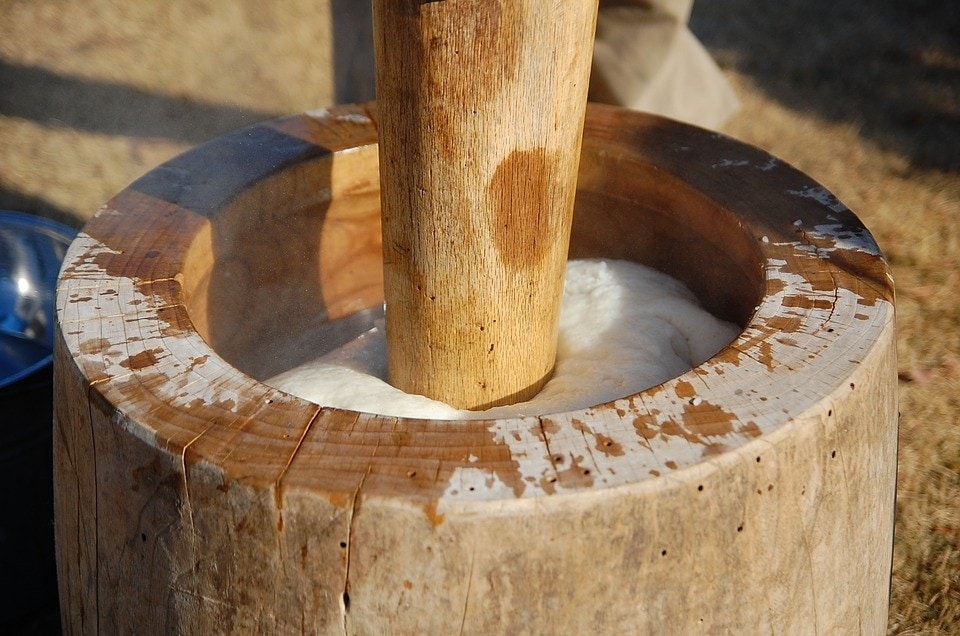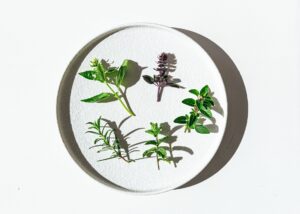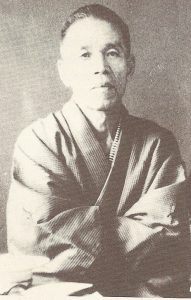Mochi 玄 米餅 are a very important part of Japanese food culture, they do not only play a role as a snack or sweet. Traditionally, mochi are made from Japanese sticky rice, called mochigome, this ceremony is called 餅 つ き mochitsuki, and it mainly takes place on the New Year. The production requires a lot of strength and skill, with the traditional Mochitsuki the hot, steamed rice is first placed in a large wooden tub (called usu) and tamped with a large wooden hammer (kine). One person hits the hot rice with a mallet, while another keeps moistening it and turning it over. The rice is processed until it becomes a very smooth, tough mass, which is then the finished mochi. After production, it is plucked into small, round pieces and dusted with plenty of starch to prevent them from sticking together.
Some of the fresh mochi is dried so it can be stored for a longer period of time, but some is consumed immediately, and fresh mochi is particularly delicious. Traditionally it is eaten with Kinako (roasted soybean flour) and a little brown sugar, with Anko (sweet bean paste) or hearty grilled with a little Shoyu , Nori and grated Daikon eaten.
The accessories for mochitsuki are made of wood and are quite heavy, so you should have a certain trust in the other person for joint mochi pounding, otherwise injuries can result. Perhaps that is precisely why long-married couples are often the best mochi pounders, after a long period of living together you are a well-rehearsed team. A mochitsuki scene is recreated in the pictures: an old couple is making mochi, the man is holding the mallet, the woman is turning the rice (such handmade Japanese dolls are called ningoyu).
Today, the annual Mochitsuki is actually only held for demonstration purposes or for tourists, as this type of preparation is really physically demanding, and today Mochi are industrially produced on a large scale and offered ready-packed. Due to this exertion, however, it was also believed that the power passes into the mochi and that it has a strengthening effect.
In the past, handmade mochi, often seasoned with iron-rich yomogi (Japanese mugwort), were served to pregnant women. Freshly mashed mochi also taste particularly good, many small mochi shops in Japan use professional machines to make them fresh every day, they are then offered all year round in many shapes and flavors. But if you really want to prepare Mochi yourself, in Japan there are Mochitsuki accessories in small format for at home (small photo on the far right) or also small electric Mochi pounders, these are not unlike our bread baking machines. We also have bread machines that can be used to make mochi at home, but another option would be this recipe here: Making mochi from rice (with the help of a food processor).
There are some customs and traditions related to mochi in Japan, much of which is associated with O-shogatsu, the Japanese New Year. 鏡 餅 Kagami Mochi (translated mirror rice cake) is the name given to two flat, round mochi placed on top of each other, with which the house is decorated for the New Year’s days. On the third day of New Year’s Eve, the Kagami Biraki takes place (translated as “breaking the mirror”), the meanwhile dry, hard mochi is broken into pieces with the help of a hammer. The mochi pieces are then eaten in the traditional o-zoni, the New Year’s soup, which also has a meaning: hot mochi pulls strings which are supposed to symbolize longevity. Mochi also play a major role in Japanese cuisine. Hot, grilled mochi are often enjoyed with shoyu and nori or coated with miso, are often a side dish in soups or are cut into small pieces and deep-fried. In Japanese shops you can buy の し 餅 Noshi Mochi for this purpose (usually with help from machines) freshly mashed, large, flat mochi, it is offered wrapped in foil and is immediately ready to eat. Mochi can also be dried, it is then individually packed and is rock-hard, but has a very long shelf life. The most important Mochi shapes are (besides the mentioned Noshi Mochi): rectangular Kiri Mochi, round Maru Mochi and oval Torinoko Mochi, one of them is in white, the other in soft pink.
There are of course a particularly large number of mochi types in the field of Japanese sweets, here it is mostly 大 福 餅 Daifuku Mochi or 求 肥 Gyūhi. Daifuku Mochi (“daifuku” means great luck) is the name given to mochi filled with sweet bean paste; the mochi itself is actually not or only slightly sweetened. There are many different types of Daifuku Mochi, the traditional fillings mostly consist of anko, sweet bean paste, but now there are also mochi with ice cream (Yukimi Daifuku) or filled with chocolate cream or pudding (Mochi Cream), which are more likely “Western” fillings. Homemade Daifuku Mochi are really delicious and not that difficult to make, a recipe for it is here.
Gyūhi is a particularly sweet and very soft mochi, which is also prepared a little differently. The name Gyūhi means something like “cow skin”. In the past, dark, unrefined types of sugar were used, so the confectionery was mostly light brown in color, reminiscent of brown cow skin.
Mochi can be made from either sticky rice (mochigome) or rice flour (like Shiratama-ko or Mochi-ko). For Daifuku Mochi, rice flour is mixed with water and cooked (traditionally it is steamed). For Gyūhi, already cooked mochi pieces are heated in hot sugar syrup and stirred vigorously, while air is mixed in until a very soft, sweet mochi with a slightly foamy texture is created. You can sometimes see the small air bubbles, with some varieties you could think that there is protein in them. Fortunately, this does not apply to most Gyūhi varieties, they are purely vegetable. There is also such a confection, which consists of mochi and egg white, but it is called “Seppei” (translated snow surface). The preparation of Gyūhi is really not easy, renowned Wagashi shops often use freshly mashed mochi here; such fine varieties are particularly delicious and are also given as gifts or served on special occasions. Gyūhi Mochi is also often a component of traditional yogashi, particularly fine sweets that are also served at a tea ceremony, whereas normal mochi is considered too simple to offer for such special matters.
Today, many Daifuku Mochi are also made from Gyūhi with the help of machines and are accordingly sweet. The main reason for this is that Gyūhi has a much longer shelf life, it stays soft for a long time and is therefore better suited for sale. Daifuku made with traditional methods unfortunately harden quickly and soon lose their freshness; they should always be enjoyed on the day of production. Wagashi and Mochi connoisseurs prefer the fresh, hand-made Daifuku, in Japan there are many shops that make and sell them fresh every day (long queues often form, and the mostly small shops are known throughout the region).
Many sweet mochi are also made directly from glutinous rice without pounding the rice into a smooth paste. This type is often the easiest to make and also tastes particularly good. Sweets like Tsubaki Mochi (Picture above), Bota mochi (also called Ohagi) and Sakura mochi (pink mochi in cherry leaf) are probably the most famous here, especially bota mochi are one of the few wagashi that are made at home in Japan. There is a very good, tried and tested recipe here: Mochi basic recipe.
As Mochigashi It is also used to denote a whole range of sweets that are based on or are similar to mochi. This also includes Wagashi like Uiro Mochi , and most of them too Dango Varieties, although both from Urumai rice (not adhesive) is made. In addition to all these delicacies made from sticky rice, there are also a number of Wagashi, which are called mochi, but are not really “real” mochi. Some of these types are particularly popular in summer. Kuzu Mochi is made from kuzu starch and, depending on the recipe, has a mochi-like texture and a very mild taste. Warabi Mochi will be off Warabi-ko Made from bracken starch, they have a fantastic, sticky texture and great taste. Kuzu and Warabi Mochi are preferably served with Kuro Mitsu (dark syrup) and Kinako (roasted soybean meal).
Snacks and sweets made from rice or glutinous rice are not only available in Japan, other Asian countries also have their own types, but these are sometimes prepared with slightly different ingredients (mostly made from long-grain sticky rice) and often have a different taste and consistency. In China they are called “Niángāo” or “Tanguyan”, in Korea “Tteok”, in the Philippines there is “Puto”, there are an incredible number of different varieties. Many of these rice cakes are quite similar to, and often confused with, Japanese mochi. The term “mochi” is definitely the most common and more familiar to many than, for example, Niangao, which is why mochi-like snacks and sweets are often referred to as “mochi”, even though they are actually other types.







